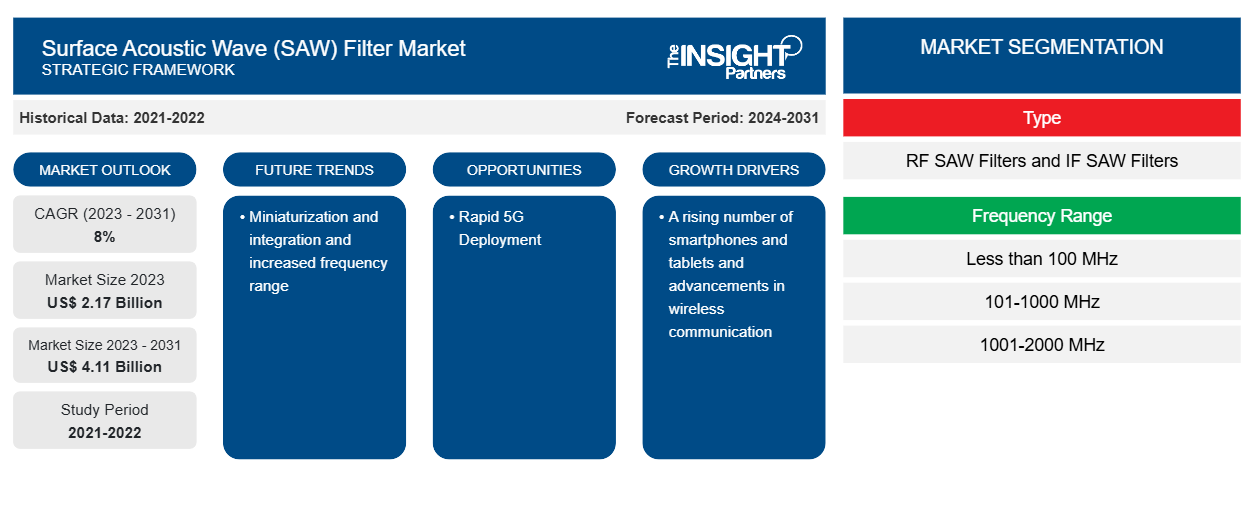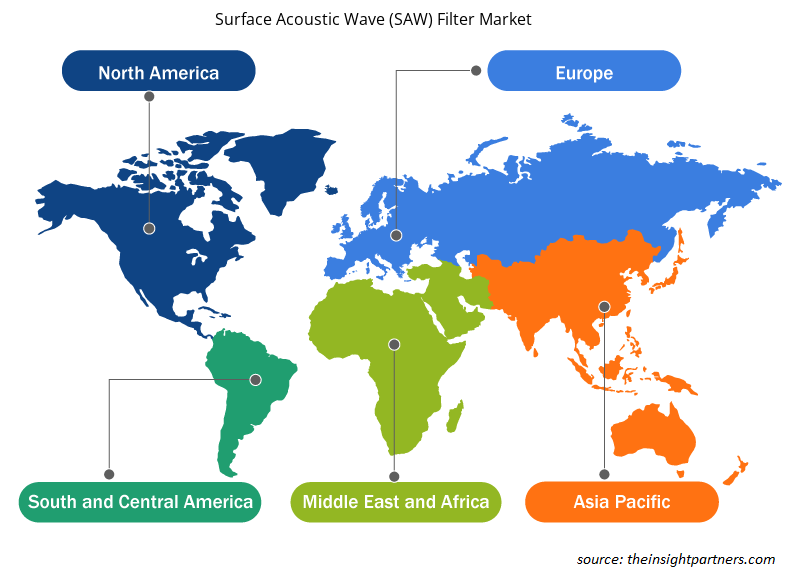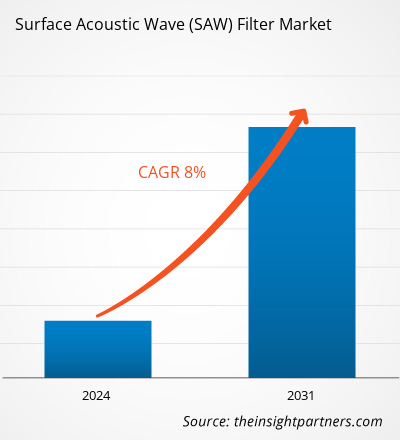The surface acoustic wave (SAW) filter market size is projected to reach US$ 4.11 billion by 2031 from US$ 2.17 billion in 2023. The market is expected to register a CAGR of 8.0% during 2023–2031. Miniaturization and integration and increased frequency range are likely to remain a key trend in the market.
Surface Acoustic Wave (SAW) Filter Market Analysis
The most popular class of SAW-filters is widely used in residential TV and radio systems, including base stations and mobile phone handsets. Numerous varieties exist, each with a unique set of benefits, including tiny size, high-frequency functioning, minimal insertion loss, and low form factor. The extreme precision with which almost limitless shapes can be formed on the surface makes a large range of types conceivable.
Surface Acoustic Wave (SAW) Filter Market Overview
Surface acoustic wave filters have been an important part of digital television sets and mobile phones. In every smartphone and other IoT device, SAW filters remain a crucial component of the communication module. SAW technology provides affordable solutions for many different kinds of uses. SAW components are a better option for a customer who needs big-volume production due to their affordable pricing. The development time of SAW components is cut down to a few weeks thanks to sophisticated simulation tools and the newest advancements in semiconductor process technology.
Customize This Report To Suit Your Requirement
You will get customization on any report - free of charge - including parts of this report, or country-level analysis, Excel Data pack, as well as avail great offers and discounts for start-ups & universities
Surface Acoustic Wave (SAW) Filter Market: Strategic Insights

- Get Top Key Market Trends of this report.This FREE sample will include data analysis, ranging from market trends to estimates and forecasts.
You will get customization on any report - free of charge - including parts of this report, or country-level analysis, Excel Data pack, as well as avail great offers and discounts for start-ups & universities
Surface Acoustic Wave (SAW) Filter Market: Strategic Insights

- Get Top Key Market Trends of this report.This FREE sample will include data analysis, ranging from market trends to estimates and forecasts.
Surface Acoustic Wave (SAW) Filter Market Drivers and Opportunities
Rising Number of Smart Phones and Tablets to Favor the Market
SAW filters are still an important part of any smartphone, having been used by manufacturers for many years since the initial generation of cell phones. Since the launch of LTE, a wide range of radio frequency bands, or LTE bands, from 600MHz to 2700MHz, have been supported by smartphones. In order to ensure global network compatibility, smartphone manufacturers incorporate the majority of LTE bands that are often used. Sub-6GHz bandwidth was made available by 5G for earlier deployments, and SAW filters are capable of capturing the majority of lower-band frequencies. SAW filter solutions provide high-performance duplexers and multiplexers for RF communication modules that power contemporary mobile devices. Globally, smartphone use is almost universal in industrialized countries. According to estimates from 2023, there are presently more than 6.5 billion smartphones in use worldwide, and this figure is expected to rise in the years to come. This is to drive the demand in the surface acoustic wave (SAW) filter market.
Rapid 5G Deployment
The need for SAW filters is being driven by the introduction of 5G technology and the expansion of Internet of Things (IoT) devices. Precise filtering is necessary for these applications to operate in complicated radio environments. The goal of ongoing research is to further reduce the size of SAW filters so they can fit into progressively smaller electronic devices without sacrificing functionality. Efforts are also underway to lower production costs and enhance performance by integrating SAW filters with other parts on a single chip.
Surface Acoustic Wave (SAW) Filter Market Report Segmentation Analysis
Key segments that contributed to the derivation of the Surface Acoustic Wave (SAW) Filter market analysis are type, frequency range, and application.
- Based on the type, the surface acoustic wave (SAW) filter market is divided into RF SAW filters and IF SAW filters. The RF SAW filters segment held the largest share in 2023.
- Based on the frequency range, the market is divided into less than 100 MHz, 101-1000 MHz, 1001-2000 MHz, and more than 2000 MHz.
- Based on the application, the market is divided into consumer electronics, automotive, aerospace and defense, telecommunications, and others.
Surface Acoustic Wave (SAW) Filter Market Share Analysis by Geography
The geographic scope of the surface acoustic wave (SAW) filter market report is mainly divided into five regions: North America, Asia Pacific, Europe, Middle East & Africa, and South & Central America.
Asia Pacific holds a significant share of the surface acoustic wave (SAW) filter market in 2023. Asia Pacific is the manufacturing hub for the semiconductor industry. Countries such as South Korea, Japan, and China are major semiconductor manufacturing hubs. Moreover, the region has a significant number of smartphone manufacturers driving the demand for SAW filters in the region.
Surface Acoustic Wave (SAW) Filter Market Regional Insights
The regional trends and factors influencing the Surface Acoustic Wave (SAW) Filter Market throughout the forecast period have been thoroughly explained by the analysts at The Insight Partners. This section also discusses Surface Acoustic Wave (SAW) Filter Market segments and geography across North America, Europe, Asia Pacific, Middle East and Africa, and South and Central America.

- Get the Regional Specific Data for Surface Acoustic Wave (SAW) Filter Market
Surface Acoustic Wave (SAW) Filter Market Report Scope
| Report Attribute | Details |
|---|---|
| Market size in 2023 | US$ 2.17 Billion |
| Market Size by 2031 | US$ 4.11 Billion |
| Global CAGR (2023 - 2031) | 8% |
| Historical Data | 2021-2022 |
| Forecast period | 2024-2031 |
| Segments Covered |
By Type
|
| Regions and Countries Covered | North America
|
| Market leaders and key company profiles |
Surface Acoustic Wave (SAW) Filter Market Players Density: Understanding Its Impact on Business Dynamics
The Surface Acoustic Wave (SAW) Filter Market is growing rapidly, driven by increasing end-user demand due to factors such as evolving consumer preferences, technological advancements, and greater awareness of the product's benefits. As demand rises, businesses are expanding their offerings, innovating to meet consumer needs, and capitalizing on emerging trends, which further fuels market growth.
Market players density refers to the distribution of firms or companies operating within a particular market or industry. It indicates how many competitors (market players) are present in a given market space relative to its size or total market value.
Major Companies operating in the Surface Acoustic Wave (SAW) Filter Market are:
- Murata Manufacturing Co., Ltd.
- API Technologies (UK) Ltd.
- Abracon
- Qualcomm Technologies, Inc.
- Qorvo, Inc.
- Skywork Solutions, Inc.
Disclaimer: The companies listed above are not ranked in any particular order.

- Get the Surface Acoustic Wave (SAW) Filter Market top key players overview
Surface Acoustic Wave (SAW) Filter Market News and Recent Developments
The surface acoustic wave (SAW) filter market is evaluated by gathering qualitative and quantitative data post primary and secondary research, which includes important corporate publications, association data, and databases. A few of the developments in the surface acoustic wave (SAW) filter market are listed below:
- Murata Manufacturing Co., Ltd. (head office: Nagaokakyo-shi, Kyoto; Chairman of the Board and President: Tsuneo Murata) has developed and started volume production of the world's smallest*1 SAW*2 duplexers*3—the SAYAV Series, SAYARV Series, and SAYAP Series; and SAW filters—the SAFFW Series (hereinafter “the Products”). (Source: Murata Manufacturing Co., Ltd., Press Release, July 2019)
- Qualcomm Technologies, Inc. introduced a new generation of micro acoustic filter technology that expands our RF front-end (RFFE) portfolio and opens up new 5G services and applications. (Source: Qualcomm Technologies, Inc, Press Release, October 2021)
Surface Acoustic Wave (SAW) Filter Market Report Coverage and Deliverables
The “Surface Acoustic Wave (SAW) Filter Market Size and Forecast (2021–2031)” report provides a detailed analysis of the market covering below areas:
- Surface acoustic wave (SAW) filter market size and forecast at global, regional, and country levels for all the key market segments covered under the scope
- Surface acoustic wave (SAW) filter market trends, as well as market dynamics such as drivers, restraints, and key opportunities
- Detailed PEST/Porter’s Five Forces and SWOT analysis
- Surface acoustic wave (SAW) filter market analysis covering key market trends, global and regional framework, major players, regulations, and recent market developments
- Industry landscape and competition analysis covering market concentration, heat map analysis, prominent players, and recent developments for the surface acoustic wave (SAW) filter market
- Detailed company profiles
Frequently Asked Questions
Which region dominated the surface acoustic wave (SAW) filter market in 2023?
Asia Pacific dominated the surface acoustic wave (SAW) filter market in 2023.
What are the driving factors impacting the surface acoustic wave (SAW) filter market?
A rising number of smartphones and tablets and advancements in wireless communication are expected to drive the surface acoustic wave (SAW) filter market.
What are the future trends of the surface acoustic wave (SAW) filter market?
Miniaturization and integration and increased frequency range are likely to remain key trends in the market.
Which are the leading players operating in the surface acoustic wave (SAW) filter market?
Murata Manufacturing Co., Ltd., API Technologies (UK) Ltd., Abracon, Qualcomm Technologies, Inc., Qorvo, Inc., Skywork Solutions, Inc., TAIYO YUDEN CO., LTD, Microchip Technologies, Inc., Kyocera Corporation, and TAI-SAW TECHNOLOGY CO., LTD. are among the leading payers operating in the surface acoustic wave (SAW) filter market.
What would be the estimated value of the Surface Acoustic Wave (SAW) Filter market by 2031?
The surface acoustic wave (SAW) filter market size is projected to reach US$ 4.11 billion by 2031
What is the expected CAGR of the surface acoustic wave (SAW) filter market?
The surface acoustic wave (SAW) filter market is expected to register a CAGR of 8.0% during 2023–2031
- Historical Analysis (2 Years), Base Year, Forecast (7 Years) with CAGR
- PEST and SWOT Analysis
- Market Size Value / Volume - Global, Regional, Country
- Industry and Competitive Landscape
- Excel Dataset
Testimonials
Reason to Buy
- Informed Decision-Making
- Understanding Market Dynamics
- Competitive Analysis
- Identifying Emerging Markets
- Customer Insights
- Market Forecasts
- Risk Mitigation
- Boosting Operational Efficiency
- Strategic Planning
- Investment Justification
- Tracking Industry Innovations
- Aligning with Regulatory Trends
Yes! We provide a free sample of the report, which includes Report Scope (Table of Contents), report structure, and selected insights to help you assess the value of the full report. Please click on the "Download Sample" button or contact us to receive your copy.
Absolutely — analyst assistance is part of the package. You can connect with our analyst post-purchase to clarify report insights, methodology or discuss how the findings apply to your business needs.
Once your order is successfully placed, you will receive a confirmation email along with your invoice.
• For published reports: You’ll receive access to the report within 4–6 working hours via a secured email sent to your email.
• For upcoming reports: Your order will be recorded as a pre-booking. Our team will share the estimated release date and keep you informed of any updates. As soon as the report is published, it will be delivered to your registered email.
We offer customization options to align the report with your specific objectives. Whether you need deeper insights into a particular region, industry segment, competitor analysis, or data cut, our research team can tailor the report accordingly. Please share your requirements with us, and we’ll be happy to provide a customized proposal or scope.
The report is available in either PDF format or as an Excel dataset, depending on the license you choose.
The PDF version provides the full analysis and visuals in a ready-to-read format. The Excel dataset includes all underlying data tables for easy manipulation and further analysis.
Please review the license options at checkout or contact us to confirm which formats are included with your purchase.
Our payment process is fully secure and PCI-DSS compliant.
We use trusted and encrypted payment gateways to ensure that all transactions are protected with industry-standard SSL encryption. Your payment details are never stored on our servers and are handled securely by certified third-party processors.
You can make your purchase with confidence, knowing your personal and financial information is safe with us.
Yes, we do offer special pricing for bulk purchases.
If you're interested in purchasing multiple reports, we’re happy to provide a customized bundle offer or volume-based discount tailored to your needs. Please contact our sales team with the list of reports you’re considering, and we’ll share a personalized quote.
Yes, absolutely.
Our team is available to help you make an informed decision. Whether you have questions about the report’s scope, methodology, customization options, or which license suits you best, we’re here to assist. Please reach out to us at sales@theinsightpartners.com, and one of our representatives will get in touch promptly.
Yes, a billing invoice will be automatically generated and sent to your registered email upon successful completion of your purchase.
If you need the invoice in a specific format or require additional details (such as company name, GST, or VAT information), feel free to contact us, and we’ll be happy to assist.
Yes, certainly.
If you encounter any difficulties accessing or receiving your report, our support team is ready to assist you. Simply reach out to us via email or live chat with your order information, and we’ll ensure the issue is resolved quickly so you can access your report without interruption.





















 Get Free Sample For
Get Free Sample For